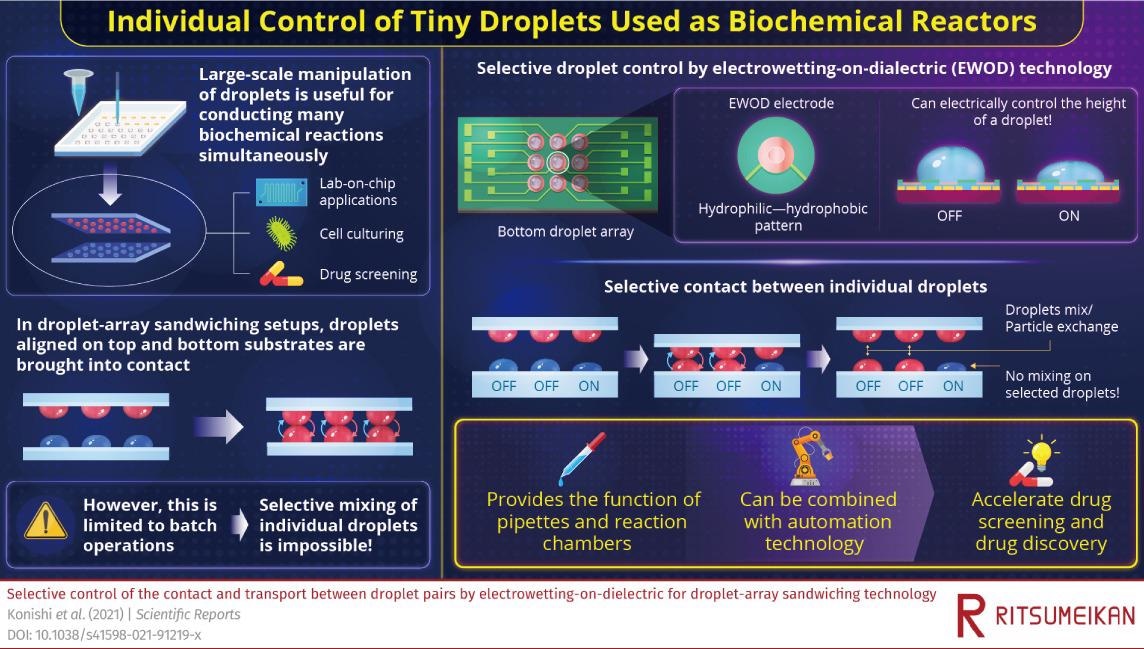The so-called “Droplet-array sandwiching” is a liquid-handling method in which small droplet pairs set out on opposite surfaces are combined by bringing the surfaces closer. Yet, this method is restricted to batch operations comprising all droplets.
 Scientists from Ritsumeikan University, Japan, developed a method to better manipulate tiny droplets in lab-on-a-chip applications for biochemistry, cell culturing, and drug screening. Image Credit: Ritsumeikan University, Japan.
Scientists from Ritsumeikan University, Japan, developed a method to better manipulate tiny droplets in lab-on-a-chip applications for biochemistry, cell culturing, and drug screening. Image Credit: Ritsumeikan University, Japan.
Researchers from Ritsumeikan University, Japan, recently discovered an approach to electrically regulating the height of separate droplets, thereby enabling them to choose which droplet pairs must unite. Their technique could help replace manual tools like pipettes and expedite drug screening.
The field of biochemistry has been quickly reshaped miniaturization, where new technologies like microfluidics and “lab-on-a-chip” devices are taking the world by storm. Chemical reactions usually carried out in tubes and flasks can currently be performed inside small water droplets not bigger than a few millionths of a liter.
Especially, in droplet-array sandwiching methods, such small droplets are laid out on two parallel flat surfaces. When the top surface is brought very close to the bottom one, every top droplet tends to contact the opposite bottom droplet, thereby exchanging chemicals and shifting particles or even cells.
In a similar approach, such droplets can serve as small reaction chambers or cell cultures, and they can also meet the role of liquid-handling tools like pipettes but on a considerably smaller scale.
The persistent problem with droplet-array sandwiching is that there is a lack of separate control of droplets; as soon as the top surface is lowered, every droplet on the bottom surface makes contact with one on the top surface.
That is, the technology is restricted to batch operations, which hampers its versatility and makes it expensive. The question is whether there are any simple means to choose which droplets must make contact when the surfaces are brought nearer.
Professor Satoshi Konishi and his collaborators at Ritsumeikan University, Japan, responded affirmatively with their research. In a new study published in the Scientific Reports journal, the research group described a new method that enables one to individually choose droplets for contact in droplet-array sandwiching.
Their ideas were quite direct: if one could regulate the height of separate droplets on the bottom surface to make some stand taller compared to others, both surfaces could be brought close together in such a way that only those droplets make contact with their counterparts while sparing the remaining ones, but achieving this was a bit complicated.
Earlier, attempts have been made by scientists to use electricity to regulate the “wettability” of the dielectric material in the area below every droplet. This method, called “electrowetting-on-dielectric (EWOD)”, allows one to slightly modify the balance of forces that carries a water droplet jointly while resting on a surface.
An electric voltage can be applied under the droplet to make it spread out slightly, which helps increase its area and decrease its height. The researchers, however, found that this process cannot easily be reversed, as droplets would not spontaneously recover their actual height as soon as the voltage is shut down.
For addressing this issue, an EWOD electrode with a hydrophilic–hydrophobic pattern was developed by the researchers. When the electrode is switched on, the earlier described process makes the droplet on top of it spread out, making it shorter.
On the contrary, when the electrode is switched off, the outer hydrophobic part of the electrode repels the droplet while it is attracted to the inner hydrophilic part. This revives the droplet’s original height and shape.
The scientists exhibited their technique by spreading out several EWOD electrodes on the bottom surface of a droplet-array sandwiching platform. With the application of voltage to chosen electrodes, the researchers could easily select the pairs of droplets that came into contact when the top platform was lowered.
For demonstration, the team shifted red dye from the top droplets to some of the bottom droplets.
Our approach can be used to electrically set up individual contacts between droplets, allowing us to effortlessly control the concentration of chemicals in these droplets or even transfer living cells from one to another.
Satoshi Konishi, Professor, Ritsumeikan University
This study set the stage for the productive combination of droplet-handling methods and automation.
We envision that lab-on-chip technology using droplets will replace conventional manual operations using tools such as pipettes, thereby improving the efficiency of drug screening. In turn, this will accelerate the process of drug discovery.
Satoshi Konishi, Professor, Ritsumeikan University
Konishi explained that culturing cells in hanging droplets has been employed in the field of cell biology and could help perform a cell-based evaluation of drugs and chemicals quickly and at low cost, thereby representing a useful tool for cell biology and biochemistry.
The researchers believe that they are not so far away from enjoying the fruits of this technology.
Journal Reference:
Konishi, S., et al. (2021) Selective control of the contact and transport between droplet pairs by electrowetting-on-dielectric for droplet-array sandwiching technology. Scientific Reports. doi.org/10.1038/s41598-021-91219-x.